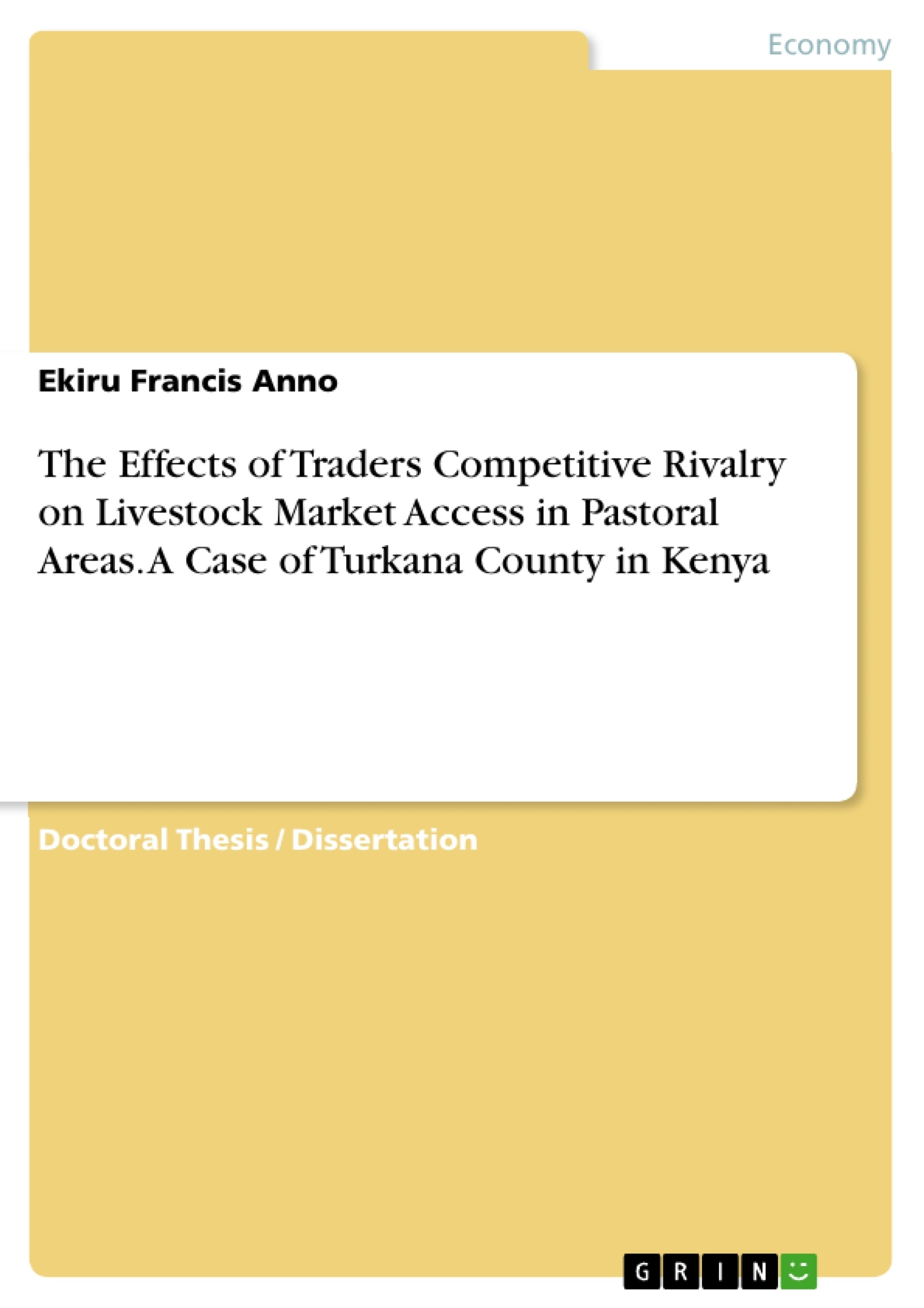The purpose of the study was to examine the effects of livestock traders' competitive rivalry on market access in pastoral areas. The study focused on how traders' socioeconomic characteristics, livestock production and marketing developments, market supply and demand relations, and business model incorporation into livestock commerce can generate knowledge and best practices for regulating competition and performance in local markets.
The rationale for investigating competition and market access factors was based on the fact that livestock-keeping is a source of livelihood depended on by over 60% of the Turkana population. While the majority of livestock development challenges are production-related, competition and market access shortfalls make potential livestock markets inefficient and non-lucrative. Exploratory and descriptive research designs and a mixed-methods research approach were used to structure the study. Data was collected from study populations, i.e., primary market traders (n = 243), secondary market traders (n = 168), and livestock specialists working for the government and civil society (n = 24). T
Knowledge generated on livestock production and marketing in pastoral areas for use by government and civil society in effective programming of livestock developments in pastoral areas is the basis for the study's critical implications for theory and practice. To structure, enhance performance, and regulate competition in livestock markets, the study underscores the importance of formulating and implementing business models and strategies leading to the most organized livestock marketing and networking among market stakeholders.
The study's findings will guide the development of the livestock sector in drylands, facilitate the creation of value-added product chains for the market, manage pricing, structure market governance, and facilitate market support networks.
Inhaltsverzeichnis (Table of Contents)
- Introduction
- Background of the Study
- Statement of the Problem
- Objectives of the Study
- General Objective
- Specific Objectives
- Research Questions
- Hypotheses
- Significance of the Study
- Scope and Delimitations of the Study
- Operational Definitions
- Literature Review
- Theories and Concepts
- Conceptual Framework
- Empirical Review
- Methodology
- Research Design
- Population and Sample Size
- Sampling Techniques
- Data Collection Techniques
- Data Analysis Methods
- Findings and Discussion
- Socioeconomic Characteristics of Livestock Traders
- Demographic Characteristics
- Economic Characteristics
- Livestock Production and Marketing Developments
- Market Supply and Demand Relations
- Price Fluctuations and Market Dynamics
- Supply Chain Efficiency and Value Chain Analysis
- Effects of Competitive Rivalry on Livestock Market Access
- Conclusion and Recommendations
- Summary of Findings
- Policy Implications
- Recommendations for Future Research
- References
- Appendices
Zielsetzung und Themenschwerpunkte (Objectives and Key Themes)
This doctoral thesis examines the impact of competitive rivalry among livestock traders on market access in pastoral areas, focusing on Turkana County in Kenya. The study aims to understand how factors such as traders' socioeconomic characteristics, livestock production and marketing practices, market supply and demand dynamics, and business model implementation influence the competitive landscape and market access for pastoral communities.
- Competitive Rivalry in Livestock Markets
- Market Access and Pastoral Livelihoods
- Socioeconomic Factors Influencing Trader Behavior
- Livestock Production and Marketing Practices
- Market Supply and Demand Dynamics
Zusammenfassung der Kapitel (Chapter Summaries)
The thesis begins by outlining the background of the study, focusing on the significance of livestock production for the Turkana population and the challenges associated with market access. Chapter 2 provides a comprehensive review of relevant literature, examining existing theories and concepts related to competition, market access, and livestock marketing in pastoral settings. The methodology chapter details the research design, data collection methods, and analysis techniques employed to gather insights into the competitive dynamics and market access issues. The findings and discussion chapter presents the results of the study, analyzing the socioeconomic characteristics of traders, the prevailing livestock production and marketing practices, and the impact of competitive rivalry on market access in Turkana County.
Schlüsselwörter (Keywords)
Key terms and concepts central to this research include livestock marketing, competitive rivalry, market access, pastoral communities, Turkana County, Kenya, socioeconomic characteristics, livestock production, market dynamics, supply chain efficiency, value chain analysis, business models, market governance, and livestock development.
- Quote paper
- Ekiru Francis Anno (Author), 2022, The Effects of Traders Competitive Rivalry on Livestock Market Access in Pastoral Areas. A Case of Turkana County in Kenya, Munich, GRIN Verlag, https://www.grin.com/document/1356828



